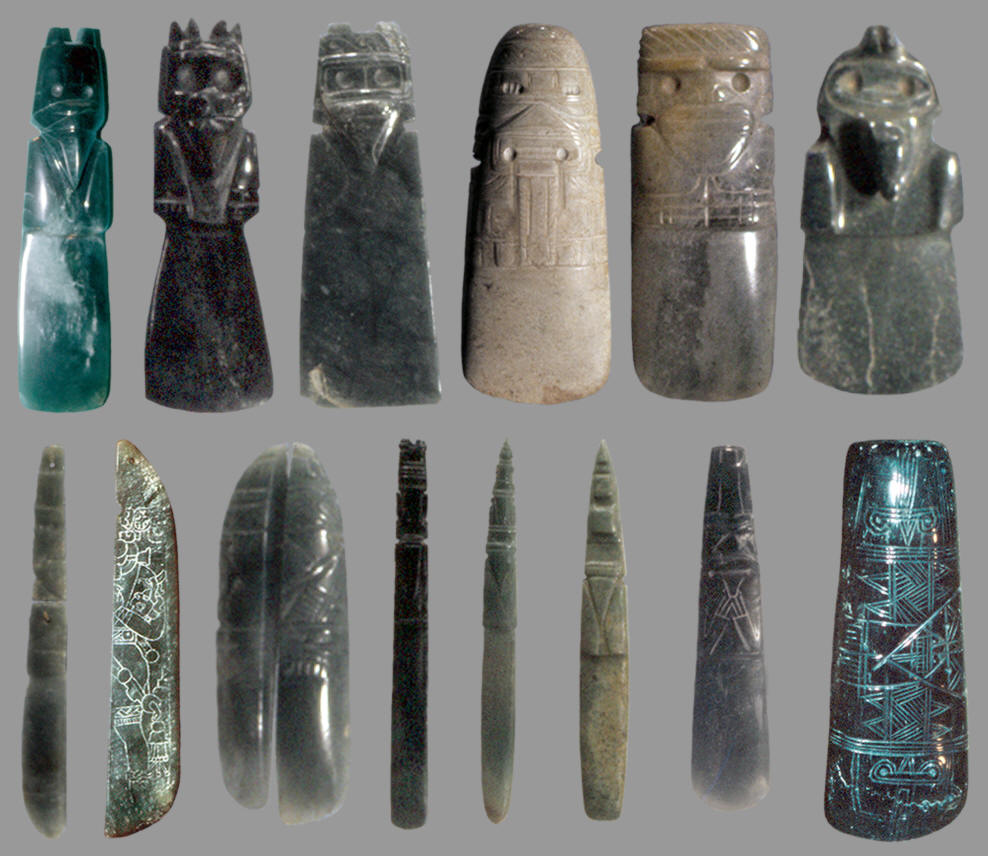|
AXE GOD PENDANTS
COSTA RICA
est. 500 B.C. TO A.D. 900
RETURN TO PAGE 1
COPYRIGHT
DECEMBER
31, 2013 PETER A. BOSTROM
This picture shows several different forms
of axe god pendants from Costa Rica. Most of them have both
avian and human design features. Some appear to be human forms
wearing bird masks and headdresses or a human wearing a bird
costume. Bird beaks in high relief or engraved triangles can be seen
on several of them. The half man, half bird theme is the most common
form of axe god. Most of these axe gods are made of jadeite and
drilled for suspension as a pendant.
The beige colored example in the top row is described as an
Olmecoid axe god. It represents one of the more impressive types of
axe god images that are human figures presented in serious poses.
They have human-like faces and long tongues that reach down to the
waste. It's believed that these large tongues may represent either
maize or falling water. There are some design features that seem to
originate from Olmec culture. The idea of revering and embellishing
celts originate with the Olmec hundreds of years before axe gods
were produced in Costa Rica. There may not be a direct connection
between the two cultures, but mythic legends may have preserved some
of these ideas. The Olmec produced engraved and stelae-like forms of
celts and Costa Rican craftsmen produced celts that were carved in
high-relief.
The long narrow axe gods in the bottom row relate to a unique
manufacturing process that involved cutting a celt into
multiple pieces but still maintaining each piece as a usable
pendant. Some were cut into two or more segments across the face
from top to bottom. Others were cut in quarter sections. Chenault
(1988) refers to these pieces as half celts, split celts and quarter
celts. When the process is finished, each segment of the axe god is
still recognizable in some way as a celt form. One reason for
segment cutting was to repair broken pendants.
The cut and engraved celt, in the bottom row second from the
left, is unique for the fact that it's a Mayan belt celt that was
cut lengthwise and re-drilled for suspension. Mayan belt celts (also
referred to as plaques) were worn
at the waste in a group of three in front over the loins by Mayan
kings. This example was found in Guanacaste Province, Costa Rica.
The engraving shows a portion of the king and all the elaborate
ornaments and dress he is wearing plus he holds a deity head on his
arm. These unique out-of-place artifacts may represent heirlooms
that were reworked and gifted to different individuals.
The axe god at lower right is categorized as a bat wing
pendant but its description involves crocodile, avian and maize
symbols. It was made on an unmodified celt form that was decorated
with engraving. The triangles in the center are identified as
crocodile scute symbols. The top eye design is described as both
crocodile jaws and the eyes of an avian figure. The design at the
bottom is described as a crocodile jaw hinge that becomes a
maize-plant symbol similar to examples found in Olmec iconography.

|
